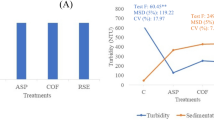Abstract
Use of mill sanitation chemicals is impaired due to lack of proper methodology to evaluate its cost - benefits to the factory. Purity drop method is incorrect, reducing sugar rise from primary juice to mixed juice is time consuming besides being prone to sampling errors. Since there is large variation in cane quality, juice composition; proper composite sampling with juice preservative is crucial. Such analysis, even carried accurately, do not indicate the upstream effect which are likely to be exerted by good biocide. It is known that biocides capable of killing microbes including thermophilic bacteria in cane juice within shortest possible time will control microbial inversion and acid formation in every stage of sugar manufacturing process. The analysis of invert sugars and titrable acidity of PJ, MJ, CI. J, syrup and molasses was carried out and it was found that use of proper biocide for mill sanitation do reflect in the analysis of final molasses. When biocide capable of killing microbes in cane juice (POLMAX ESR is specially developed formulation for such purpose) is applied for mill sanitation, there is steady but small rise in invert sugar % brix and titrable acidity % brix between every stage of sugar processing. Titrable acidity and invert sugar per 100 brix of final molasses was much lower when POLMAX ESR is used and the difference is substantial and can be used to evaluate saving of sugar loss from microbial inversion. Data of 5 representative factories is presented.
Similar content being viewed by others
References
Chen, J.C.P. and Chou, C.C. (1993). The Cane Sugar Handbook. 12th Edition, John Wiley and Sons, New York.
Kulkarni, V.M. (1999). Analysis of molasses as an appropriate method for evaluating efficacy of mill sanitation biocides. Preprints Factory Programme, Proc. 23rd. ISSCT, New Delhi (India), p. 352–357.
Solomon, S., Shrivastava, A.K., Srivastava, B.L. and Madan, V.K. (1997). Pre-milling sugar losses and their management in sugarcane. Technical Bulletin No. 37. Indian Institute of Sugarcane Research.
Solomon, S.,Shahi, H.N.,Rais, Ahmed and Madan, V.K. (1999). AIDS-Syndrome affects sucrose recovery : Cane sanitation must precede mill sanitation. Proc. 23rd ISSCT, New Delhi (India). Factory Programme Preprints, p. 348–351.
Solomon, S., Shahi, H.N., Singh, Ishwar and Madan, V.K. (1999). Dynamics of post-harvest sucrose losses in sugarcane during late-crushing period. Proc. Annual Conv. STAI, 61: 157–165.
Author information
Authors and Affiliations
Rights and permissions
About this article
Cite this article
Kulkarni, V.M. A novel method to evaluate efficacy of mill sanitation biocides: Reducing sugar and titrable acidity analysis of final molasses. Sugar Tech 1, 54–62 (1999). https://doi.org/10.1007/BF02945164
Published:
Issue Date:
DOI: https://doi.org/10.1007/BF02945164




